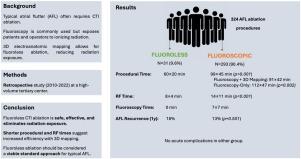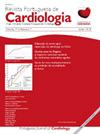Fluoroless cavotricuspid isthmus ablation of typical atrial flutter achieves success with shorter radiofrequency and procedural times
IF 1.6
4区 医学
Q3 CARDIAC & CARDIOVASCULAR SYSTEMS
引用次数: 0
Abstract
Introduction and objectives
Cavotricuspid isthmus (CTI) ablation for typical atrial flutter (AFL) has improved in recent years, especially with three-dimensional (3D) electroanatomic mapping systems. These tools allow a better understanding of the arrhythmia with higher ablation success rates while reducing radiation exposure. However, most ablation procedures still require varying amounts of fluoroscopy. Our aim was to examine whether fluoroless CTI ablation is effective and safe in reducing AFL recurrence, compared with CTI ablation using fluoroscopy.
Methods
We conducted a retrospective analysis of CTI ablations performed at a tertiary center between December 2010 and December 2022. Patients were divided into two groups: fluoroless and fluoroscopic, according to the use of radiation. Procedural duration, fluoroscopy time (FT), radiofrequency time (RF), acute complications and recurrence rates at one year were analyzed.
Results
A total of 324 CTI ablations were performed. Mean age was 62.3±14.0 years, with 78.1% male patients. The FT was zero in the fluoroless group (n=31), and 7.0±7.0 minutes in the fluoroscopic group (n=293) (p<0.001). There was no statistically significant difference between the two groups, regarding AFL recurrence at one year. RF was shorter in the fluoroless group (8±4 vs. 14±11 minutes, p<0.001). Total time procedure duration was shorter in the fluoroless group (60±20 minutes vs. 99±45 minutes, p<0.001). There were no acute complications.
Conclusion
Fluoroless CTI ablation, avoiding any radiation exposure to the patient and operator, can be performed in patients with typical AFL, without compromising duration, safety or efficacy of the procedure.

典型心房扑动的无氟腔尖瓣峡部消融术以较短的射频和手术时间获得成功。
前言和目的:近年来,特别是三维(3D)电解剖定位系统的应用,对典型心房扑动(AFL)的心房三尖瓣峡部(CTI)消融治疗有了很大的改善。这些工具可以更好地了解心律失常,在减少辐射暴露的同时具有更高的消融成功率。然而,大多数消融手术仍然需要不同数量的透视检查。我们的目的是研究与使用荧光透视的CTI消融相比,无荧光CTI消融在减少AFL复发方面是否有效和安全。方法:回顾性分析2010年12月至2022年12月在三级中心进行的CTI消融。根据放疗方式的不同,将患者分为无透视组和透视组。分析手术时间、透视时间(FT)、射频时间(RF)、急性并发症及1年复发率。结果:共行324例CTI消融。平均年龄62.3±14.0岁,男性占78.1%。无荧光组(n=31)的FT为0,透视组(n=293)的FT为7.0±7.0分钟(p结论:无荧光CTI消融可用于典型AFL患者,避免对患者和操作人员的任何辐射暴露,且不影响手术的持续时间、安全性和有效性。
本文章由计算机程序翻译,如有差异,请以英文原文为准。
求助全文
约1分钟内获得全文
求助全文
来源期刊

Revista Portuguesa De Cardiologia
CARDIAC & CARDIOVASCULAR SYSTEMS-
CiteScore
2.70
自引率
22.20%
发文量
205
审稿时长
54 days
期刊介绍:
The Portuguese Journal of Cardiology, the official journal of the Portuguese Society of Cardiology, was founded in 1982 with the aim of keeping Portuguese cardiologists informed through the publication of scientific articles on areas such as arrhythmology and electrophysiology, cardiovascular surgery, intensive care, coronary artery disease, cardiovascular imaging, hypertension, heart failure and cardiovascular prevention. The Journal is a monthly publication with high standards of quality in terms of scientific content and production. Since 1999 it has been published in English as well as Portuguese, which has widened its readership abroad. It is distributed to all members of the Portuguese Societies of Cardiology, Internal Medicine, Pneumology and Cardiothoracic Surgery, as well as to leading non-Portuguese cardiologists and to virtually all cardiology societies worldwide. It has been referred in Medline since 1987.
 求助内容:
求助内容: 应助结果提醒方式:
应助结果提醒方式:


